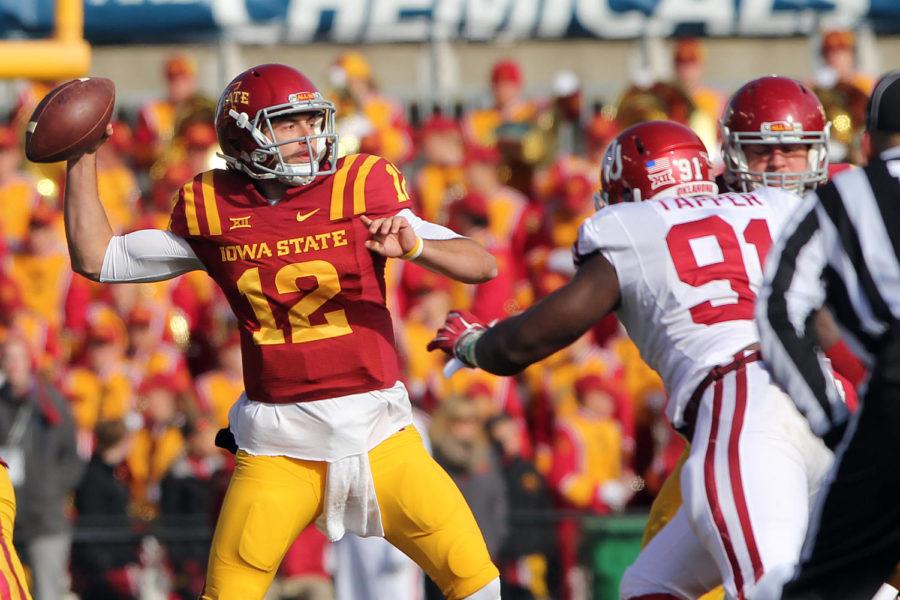The good, the bad and the ugly: A season in review
Redshirt junior quarterback Sam Richardson throws the ball during Iowa State’s game against Oklahoma on Nov. 1. Richardson had 15 completions, rushed for 20 yards and scored an 18-yard touchdown. The Cyclones fell to the No. 19 Sooners with a final score of 59-14.
December 11, 2014
The ISU football team knew the 2014 season was going to be a bit of a rebuilding year. The defense had graduated its leader and All-Big 12 first team linebacker Jeremiah George, as well as All-Big 12 second team defensive back Jacques Washington.
There was youth at nearly every position, seven coaching changes were made in the offseason and a quarterback battle kept fans guessing as to who would lead the offense late into fall camp. The releases of David Irving and Rodney Coe on the defensive line furthered the cause for concern.
But after Paul Rhoads’ first four years of successes reaching bowl games and upsetting some of the top teams in the nation, many fans thought the 3-9 record of the 2013 season may have just been a flub, and despite what the national media had labeled as a rebuilding year, hopes built for another bowl campaign.
So, a 2-10 record wasn’t exactly what fans or the team had hoped for. Injuries, a difficult schedule and late game breakdowns aided in Iowa State’s first 10-loss season since 2008, when the team was coached by Gene Chizik.
“We had four kids who started every game this year. Four kids,” said ISU coach Paul Rhoads. “We had six that started every game in 2013. I’d like to have 16, I’d like to have 14.”
But as the 2014 season closes, we will look at the good, the bad and the ugly moments of the season.
The good
Not much went well for the Cyclones on a large scale, but the bad often overshadowed the good things happening on a smaller scale for much of the season.
The obvious highlight of the season was a 20-17 road win over in-state rival Iowa. Redshirt sophomore Cole Netten kicked his way into the spotlight on a game-winning field goal, ending the season as the ISU career field goal percentage leader.
Quarterback Sam Richardson also had a record-breaking year, setting ISU records for most completions in a game in a win against Toledo, and most completions in a season, while throwing for 18 touchdowns — two shy of the school record.
However, tight end E.J. Bibbs stole the show for much of the season, finishing among the best tight ends in the nation in receptions and touchdown catches, despite missing the team’s final two games due to injury. A John Mackey semifinalist, Bibbs ended up one touchdown short of tying the school record for receiving touchdowns in a season.
The bad
Season-ending injuries defined the season for the Cyclones, knocking out arguably the team’s best player, Quenton Bundrage, just four plays into the season.
Injuries piled up, likely contributing to late breakdowns in losses to Kansas State and Texas. The defensive line struggled to keep up, as its youth started to show.
A 21-point loss to Baylor was bad, but not unexpected as the Bears came in as the top offense in the nation, as well as one of the best defenses. But after Jevohn Miller went down with a knee injury against Oklahoma, the defense fell apart.
The ugly
It started against North Dakota State. The young defense showed its youth early, giving up 34 points to the Bison.
But Miller’s move to Mike linebacker appeared to put a bandage over the worst of the defense’s weaknesses. As soon as he went down with an injury against Oklahoma, they fell apart. A Miller-less defense gave up more than 500 yards of offense in each of the final five games of the season.
Kansas took down a goal post after defeating the Cyclones, and what was left of the season went down with it.
“Bad” was the only word center Tom Farniok could use to describe it. Ugly might have been better.
Moving forward
While it’s the ugly that will stick with the 2014 football team in the minds of fans and outsiders, the future is the only thing the team is looking at. The defensive line picked up a commitment from the 2013 National Junior College Athletics Association Defensive Player of the Year days after the season ended and Rhoads said he didn’t anticipate any coaching changes after the TCU game — an area in which there has been a lot of turnover in the last few seasons.
The focus now is on development, not only physically, but mentally.
“We’ll get a year’s worth of strength gains and speed gains and so forth,” Rhoads said. “But we’ve got to become a smarter football team.”
Most importantly, the team will have to put 2014 in the past if it ever hopes to look forward. Good chunks of the team return to the field in 2015, but after dealing with adversity and hardships all season, moving forward may be the toughest part.
“Being 0-9 [in the Big 12] and being 2-10 [overall], that’s hard probably for an 18, 19, 20-year-old to fully grasp at this point,” Rhoads said. “Knowing the talent of some of our younger players, knowing the desire and leadership inside of our younger players, we are a lot closer than we are further away, but a lot has to take place to get over that hump.”







